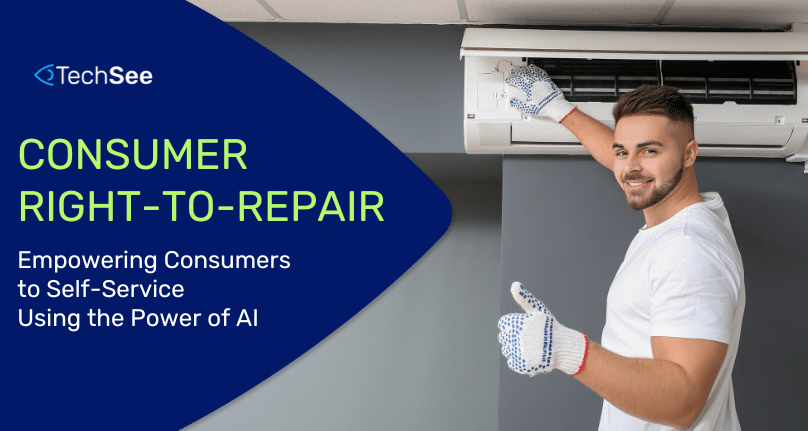Contents
Introduction
The right-to-repair movement has gained significant momentum in recent years, giving consumers the ability, and resources needed to repair their electronics and devices themselves rather than relying solely on authorized repair centers. This movement aims to promote sustainability, cost-effectiveness, and consumer empowerment. Alongside this, advancements in artificial intelligence (AI) and computer vision technology have revolutionized support centers, field service, and self-service in the electronics industry. This blog explores the right-to-repair policy developments, their implications for consumers, and how AI-powered solutions, like TechSee, can support companies facing right-to-repair concerns.
The Right to Repair Movement
In the article, “A Right to Repair Movement Tools Up” The Economist advocates for consumer rights in repairing their own electronics and appliances. Allowing individuals to avoid being forced into costly and time-consuming repairs at authorized centers, or having to replace an item that could otherwise be fixed, potentially providing significant savings and convenience for consumers.
A Pioneering Step: The EU’s Right to Repair Legislation
One significant development in the right-to-repair is the introduction of a new right-to-repair law in the European Union. As of March 2021, the European Union enacted groundbreaking legislation that mandates manufacturers of appliances, such as refrigerators and televisions, to provide spare parts and repair information to consumers. This policy aims to facilitate easier and more accessible repairs, thereby promoting sustainability and reducing electronic waste. Manufacturers must also design products that are easy to repair, ensuring spare parts availability for a reasonable period. The EU’s initiative has set a precedent for other regions to follow and reflects the growing concern for consumer rights in the electronics industry.
Advancements in the United States
In the United States, there have also been several developments in the right-to-repair policy. In April 2021, President Biden signed The Executive Order on Promoting Competition in the American Economy calling for the Federal Trade Commission to develop rules enabling consumers to repair their own devices. This move came in response to rising concerns about the escalating costs of repairs, complex device designs, and the environmental impact of disposable electronics. It marks a significant step towards strengthening consumer rights and promoting a more sustainable electronics industry in the country.
The Role of AI and Computer Vision in Support Centers and Self-Service
As the right-to-repair movement gains traction, companies are exploring innovative ways to empower consumers to troubleshoot and fix their devices independently. AI-powered solutions, such as computer vision, play a pivotal role in enhancing support centers and self-service experiences.
- TechSee’s AI-Powered Support Solutions: TechSee’s AI-powered Computer Vision support solutions, offer companies a robust platform to enhance customer support by leveraging computer vision technology. TechSee’s platform allows customers to receive remote support through real-time video sessions. With this visual assistance, consumers can accurately diagnose issues, follow step-by-step repair instructions, and resolve problems efficiently.
- Empowering Consumers through Self-Service: By incorporating TechSee’s AI-powered Visual Automation for Self-Service manufacturers can empower consumers to diagnose and fix issues on their own. This capability saves time, reduces expenses on unnecessary repairs, and fosters a sense of autonomy among consumers.
Benefits for Companies
For companies dealing with right-to-repair concerns, AI-powered visual support solutions offer several advantages. By offering visual assistance, manufacturers can gather valuable data on common issues and trends, enabling them to improve product designs and provide better support to their customers. Additionally, remote visual support reduces the need for in-person repairs, leading to cost savings and increased customer satisfaction.
Conclusion
The right-to-repair movement, alongside advancements in AI and computer vision technology, marks a significant turning point for the electronics industry. Consumers are gaining more autonomy and control over their devices, promoting sustainability, cost-effectiveness, and improved customer experiences. Solutions like TechSee’s AI-powered visual support platform are reshaping customer support and self-service, enabling consumers to troubleshoot and resolve issues independently while supporting companies in providing efficient and effective assistance.
As technology continues to evolve, we can expect further advancements in AI-powered solutions, further empowering consumers and fostering a more consumer-friendly and sustainable electronics industry. Embracing the right-to-repair philosophy and integrating AI-driven tools, companies can position themselves at the forefront of customer-centric innovation in the dynamic world of technology.







